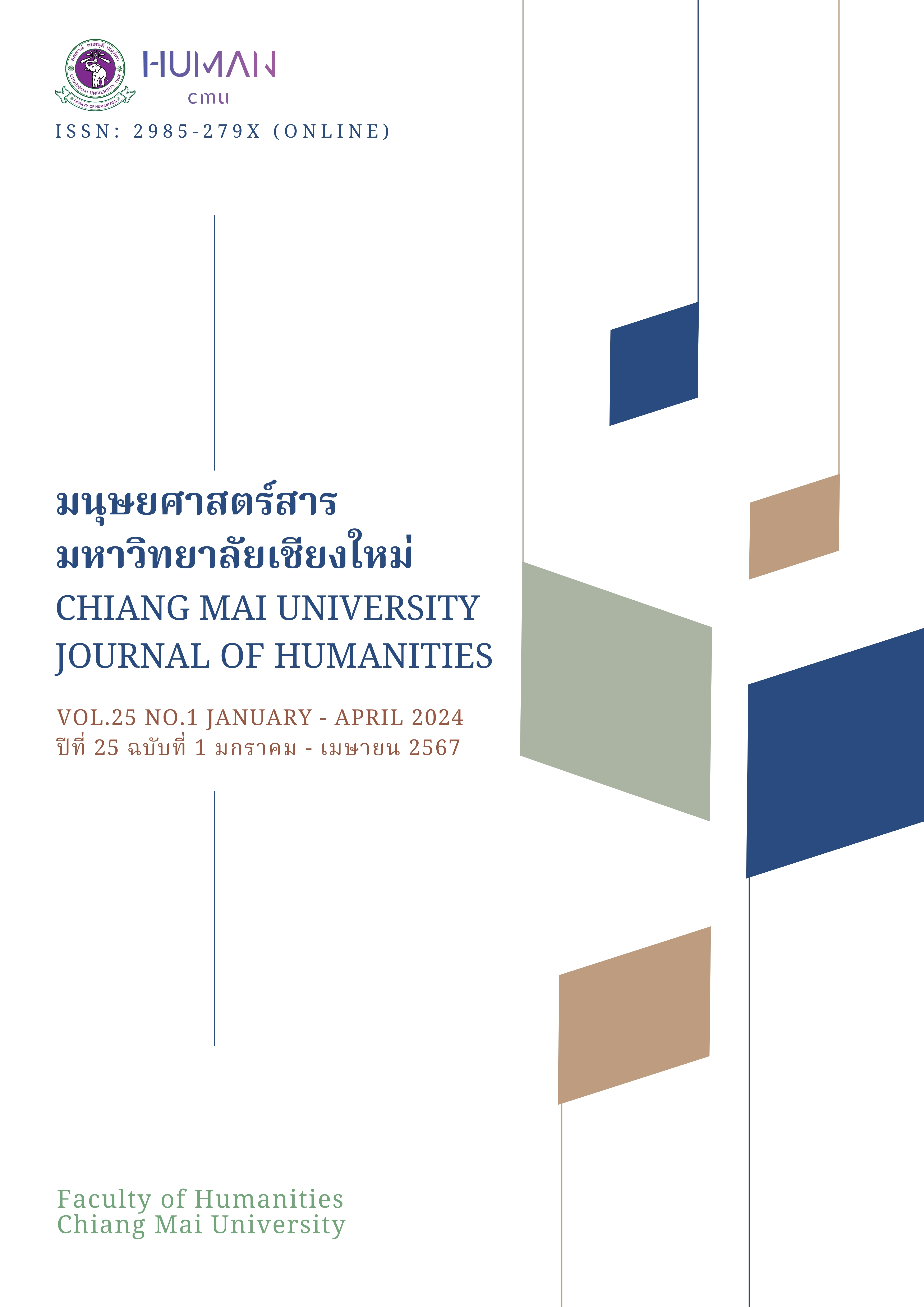การ พัฒนาชุดรายการคำศัพท์ภาษาจีนพื้นฐานทางการแพทย์ที่มีความถี่ในการใช้งานสูงสำหรับสถาบันเสริมความงามในจังหวัดลำปาง
Main Article Content
บทคัดย่อ
งานวิจัยครั้งนี้มีเป้าหมายในการศึกษา วิเคราะห์ และพัฒนารายการคำศัพท์ที่ปรากฏใช้จริงในสถาบันเสริมความงาม เพื่อนำมาเป็นแนวทางแก้ไขปัญหาด้านการสื่อสารให้กับผู้เข้ารับการบริการชาวจีนในสถาบันเสริมความงาม ประชากรและกลุ่มตัวอย่าง ได้แก่ สถาบันเสริมความงามในจังหวัดลำปาง ทั้งหมด 10 แห่ง ที่ได้รับรองมาตรฐานจากกระทรวงสาธารณสุข และผู้ใช้บริการด้านการเสริมความงามในจังหวัดลำปาง 150 คน เครื่องมือที่ใช้ในการวิจัยเป็นแบบสัมภาษณ์ แบบสอบถาม และการเข้าสังเกตการณ์ เพื่อเก็บข้อมูลความถี่ของการใช้คำศัพท์ และเพื่อเข้าใจถึงปัญหาด้านการสื่อสาร อีกทั้งยังได้วิเคราะห์จัดลำดับตามจำนวนความถี่ของคำศัพท์ที่ปรากฏ จำแนกประเภทของคำศัพท์ และกระบวนการแปลคำศัพท์ในสถาบันเสริมความงามเป็นภาษาจีน ด้วยการวิเคราะห์แบบอุปนัยและสถิติพรรณนา
ผลการวิจัยพบว่า คำศัพท์ทั้งหมดจำนวน 1,207 คำ มีความถี่ที่ปรากฏรวม 87,080 ครั้ง คำศัพท์ที่มีความถี่ปรากฏใช้จริงมากที่สุดอันดับแรก คือ “ผิว” มีความถี่ที่ปรากฏจำนวน 714 ครั้ง คิดเป็นร้อยละ 0.820อันดับที่ 2“หน้า” มีความถี่ที่ปรากฏจำนวน 658 ครั้ง คิดเป็นร้อยละ 0.756 อันดับที่ 3“คลินิก” มีความถี่ที่ปรากฏจำนวน 625 ครั้ง คิดเป็นร้อยละ 0.718 อีกทั้งปัญหาด้านการสื่อสารที่พบเจอ ได้แก่ 1) สำเนียงการออกเสียงภาษาจีนกลางของผู้ให้และรับบริการส่งผลต่อการสื่อสาร 2) ทักษะการสื่อสารภาษาต่างประเทศอื่นของผู้ให้และรับบริการมีความอ่อนแอ 3) คำศัพท์เฉพาะในสถาบันเสริมความงามมีความซับซ้อนเกินไปสำหรับบุคคลทั่วไป และอื่น ๆ ทั้งนี้ผู้วิจัยได้ชี้แนะแนวทางการแก้ไขปัญหาให้แล้วเสร็จทั้งการสร้างรายการคำศัพท์ที่จำเป็นต่อการใช้งานเพื่อพัฒนาทักษะการสื่อสารภาษาจีน และการพัฒนาบุคคลากรของสถาบันเสริมความงาม เพื่อนำผลการวิจัยไปใช้ให้เกิดประโยชน์สูงสุด
Article Details

อนุญาตภายใต้เงื่อนไข Creative Commons Attribution-NonCommercial-NoDerivatives 4.0 International License.
เอกสารอ้างอิง
Aroonmanakun, W. (2002). Corpus Linguistics. Faculty of Arts, Chulalongkorn University.
Burns, P. C., & Lowe, A. L. (1966). The Language Arts in Childhood Education. Chicago: Rand McNally.
Catford, J. C. (1965). A Linguistic Theory of Translation. London: Oxford University Press.
Crystal, D. (1991). A Dictionary of Linguistics and Phonetics. (3rd ed.). Oxford: Blackwell Publishers.
Department of Highways. (2023). Tourism Geographic Information System [ระบบสารสนเทศภูมิศาสตร์เพื่อการเดินทาง]. DOH to Travel. http://dohgis.doh.go.th/dohtotravel/
Donsont, T. (2020). Influencing Factors on Surgery Decision of Young Adult (Independent Study Master of Business Administration). Bangkok: Graduate Programs Siam University.
Harmer, J. (1991). The practice of English language teaching. Longman Handbooks for Language Teachers. (4th Ed.). Harlow, England: Pearson Longman.
Kasikorn Research Center. (2018). Private Hospital Business, 2018: Opportunities to Tap into Chinese Medical Tourists [ธุรกิจโรงพยาบาลเอกชนปี’ 61 โอกาสขยายฐานลูกค้า Medical Tourism สู่ตลาดนักท่องเที่ยวจีน]. Kasikorn Research Center. https://www.kasikornresearch.com/th/analysis/k-econ/business/Pages/z2912.aspx
Mallikamas, P., & Aroonmanakun, W. (2006). Impacts of Specialized English Corpus on Translation between English and Thai. Journal of Liberal Arts, Thammasat University, 6(1), 99-136.
McCarthy, M. (1992). Vocabulary. Oxford University Press.
Newmark, P. (1988). A Textbook of Translation. London: Prentice Hall International (UK) Ltd.
Nida, A., & Taber, R. (1982). The Theory and Practice of Translation (2nd Ed.). Leiden E.J. Brill: The United Bible Society.
Numtong, K. (2020). Translation Skills from Chinese to Thai. Bangkok: Eastern Languages, Kasetsart University.
Numtong, K., & Likhitcharoentham, S. (2020). Principles and precautions in translating Chinese to Thai language and Thai to Chinese language. Chinese Studies Journal, 12(2), 105-151.
Publication Department TCIJ. (2018) Thailand is expected to attract 6% of "Chinese medical tourism" in 2018 [คนไทยรู้ยัง : คาดไทยดูด 'Medical Tourism จีน' ได้ 6% ในปี 2561]. Tcijthai. https://www.tcijthai.com/news/2018/08/scoop/8048
Sanguanphon, S. (2012). Medical Interpreting Service For Foreigners in Japan. Thammasat Journal of Japanese Studies, 29(2), 92-107.
Schmitt, N. (2020). Vocabulary in language teaching. (2nd Ed.). United Kingdom: Cambridge University Press.
Sinhaneti, K. (1981). Scientic English. Pasaa Paritat Journal of Chulalongkorn University, 2(2), 14-29.
Suphasirikitcharoen, J., & Boonjaroenpol, B. (2015). FactorsAttracting Foreign Patients to Medical Service in Thai Private Hospital. Research and Development Journal Loei Rajabhat University, 10(32), 114-123.
Suthisom, P. (2014). List of 1,000 Basic Words in Science and Technology for Quality of Life and Society (SC 103) for Chinese Students Using Thai as a Second Language of Dhurakij Pundit University. (n.p.)
Thairath Online. (2023) Why is the direction of "cosmetic surgery" in Thailand popular all over the world? [ทิศทาง "ศัลยกรรมความงาม" ในไทยทำไมถึงได้รับความนิยมระดับโลก]. Thairath Online. https://www.thairath.co.th/news/society/2698100
Zhang, P. (1983). 英汉翻译教程.上海: 上海外语教育出社.


